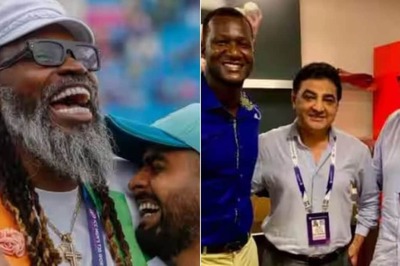
views
New Delhi: The Supreme Court will on Friday announce its verdict on a batch of petitions seeking the entry of women aged between 10 and 50 into Kerala's Sabarimala temple.
The five-judge bench of the court, headed by CJI Dipak Misra, had in August reserved its verdict on the pleas challenging the age-old practice. Before the SC bench assembles to deliver this landmark verdict, News18 breaks down the key issues involved and how the case progressed.
Which is this temple and what does it prohibit?
The Sabarimala Temple, considered the abode of Lord Ayyappa, is located in the Periyar Tiger Reserve in the Western Ghat mountain ranges of Pathanamthitta District, Kerala. It is believed that Lord Ayyappa was born out of the union between Lord Shiva and the mythical Mohini, who is also regarded as an avatar of Lord Vishnu.
The temple prohibits the entry of women in their ‘menstruating years’ (between the ages of 10 to 50), on the grounds that it is a place of worship.
Is there a legislation banning the entry or it a temple specific decision?
Travancore Devaswom Board is said to have the legal authority to manage the Sabarimala temple's administration. The board has heavily relied on Article 26 of the Constitution, which guarantees a religious denomination of right to manage its own internal religious affairs.
Furthermore, the Sabarimala custom of not allowing entry to women is protected by Rule 3(b) of the Kerala Hindu Places of Public Worship (Authorization of Entry) Rules, 1965 '"Public Worship Rules'). The rule allows the exclusion of women from public places of worship, if the exclusion is based on 'custom'.
When did the fight to do away with the woman ban at Sabarimala began?
In 1991, this ban was first challenged before the Kerala High Court in S Mahendran vs The Secretary, Travancore. The Court ruled that the ban was constitutional and justified, as it was a long-standing custom prevailing since time immemorial.
In 2006, Indian Young Lawyers Association filed a PIL before the Supreme Court challenging the Sabrimala Temple's custom of excluding women. The Association made a case that custom of banning women entry violates the rights to equality under Article 14 and freedom of religion under Article 25 of female worshipers.
On 7th March 2008, the matter was referred to a three-judge Bench. It came up for hearing seven years later, on 11th January 2016.
On 20th February 2017, the Court expressed its inclination to refer the case to a Constitution Bench. Finally on October 13, 2017, a bench comprising Chief Justice Dipak Misra, Justice R Banumathi, and Justice Ashok Bhushan ordered a Constitution Bench to pass judgement on the case. Thus, a constitution bench-led by CJI Misra to hear the case was constituted.
What were the primary issues that are at stake?
The case essentially has four issues for the court to deal with. First, the rule that disallows women from entering temples for the sake of custom is challenged so as to prove that it violates Articles 14 and 15(3) of the Constitution on the grounds of sex.
The second issue is whether the practice constitutes an ‘essential religious practice’ under Article 25? Whether a religious institution can assert its claim to do so under the right to manage its own affairs in the matters of religion?
The third issue is whether the exclusionary practice based on a biological factor exclusive to the female gender amounts to ‘discrimination’? and, lastly, Whether Sabarimala temple has a denominational character?
What are some of the key submissions made by the petitioners in this case seeking to overturn the ban?
Prohibiting entry of women from 10 to 50 amounts to untouchability: Senior counsel Indira Jaisingh stated that prohibition of women entry is a form of untouchability. “The sole basis of restriction is menstruation of women. To keep away menstruating women is a form of untouchability. Menstruating women are seen as polluted.”
Restriction to entry not connected to religious practice: The petitioners argued that restriction on the entry of women in the Sabarimala temple is nowhere connected with the religious practices performed there. The question of it being the essence of the said religious denomination does not arise at all.
Sabarimala Temple not a separate religious denomination: It was argued that the Lord Ayyappa temple was not a separate religious denomination for the purpose of Article 26 because the religious practices performed in Sabarimala Temple at the time of ‘Puja and other religious ceremonies are not distinct and are akin to any other practice performed in any Hindu Temple.
Article 25(2) (b) was not a mere enabling provision: Senior Advocate Raju Ramachandran who was appointed as amicus curiae in the matter stated that the right of women to enter temple and offer worship flowed from Article 25(2) (b) as it was not a mere enabling provision which permitted enactment of law to make Hindu temples accessible to all sects and classes, but granted a substantive right.
Justice Indu Malhotra cited example of a temple which ban entry of men: Justice Malhotra had cited the example of Attukal Bhagavathy Temple in Kerala, which is exclusively for women devotees, and asked whether exclusion of men was discriminatory. Responding in affirmative, Surendranath submitted that it was equally discriminatory.
How did Travancore Devaswom Board justify the ban?
Lord Ayyappa was a celibate for life, a ‘Naishtika Brahmacharya’: Senior Advocate Abhishek Manu Singhvi, who argued for the Devaswom Board, justified the impugned practice as being a bonafide one, one originating from the character of the deity at the Sabarimala Temple. Lord Ayyappa was a celibate for life, a ‘Naishtika Brahmacharya’, and the practise was firmly rooted on this belief of hordes of devotees.
Woman cannot complete 41 days of penances: Observance of 41 days of penances was essential for undertaking a pilgrimage to Sabarimala. It was an essential religious practice. It was not physiologically feasible for women to complete the 41 days of penances.
Chief of temple decides the custom: The exclusive authority of the ‘Thanthri’ of the Sabarimala Temple to decide all religious, ritualistic and spiritual controversies pertaining to the denominational temple was submitted.
The ban on women entry was not misogynistic: A case was made that women in Kerala are socially advanced, owing to their education, and most of them are not opposed to the practises followed in Sabarimala. It was also stated that Hindu communities in Kerala followed matrilineal practises, and thus the contention that they were being subjugated was not proper.
Lord Ayappa is a legal person: Signhvi had argued that upon the establishment of an idol, life is infused into it, which flourishes with the continuous offering of prayers in the manner stipulated in the ‘Shastras’ or religious authorities. It was stated that every idol possesses a unique nature, a special character, which has its roots in the religion, and each temple accordingly observes distinct traditions and rituals, which are respected and followed by reasonable devotees.
God has right to remain celibate: It was argued that Lord Ayyappa’ s right to maintain his ‘perpetual celibate’ status was covered under the right to privacy under Article 21.
Did the Kerala government state that it supports the entry of women into the temple?
During the hearing of the case in July this year, the state government expressed that it supported the entry of women, which in turn had out Travancore Devaswom Board in a spot.
"The state government supports the entry of women. The state is not opposing," senior advocate Jaideep Gupta told the bench which also comprised Justices RF Nariman, AM Khanwilkar, DY Chandrachud and Indu Malhotra.
The lawyer said that it was relying on its earlier affidavit. The then Congress-led United Democratic Front (UDF) government had filed an affidavit in 2015 in the apex court supporting the entry of women of all age group inside the temple. Later the Left Democratic Front (LDF) government, in 2017, made the U-turn and opposed the entry of women.




















Comments
0 comment